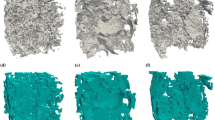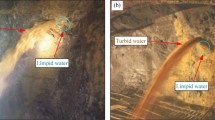Abstract
The Xiangxi River basin, South China is a steep terrain that hosts an extensive karst aquifer system with rapid subsurface runoff. The karst networks are best developed in Cambrian carbonates along the NNW and NNE directions, congruent with the predominant orientations of fissures, the permeability tensor, surface features, and flow channels. Tracer tests define a fast subsurface flow component with a maximum velocity of 240–1055 m/h that discharges to multiple outlets at high water levels, and a slow flow component with a velocity of 15 m/h at low water levels. A theoretical response model defined the response times of four karst springs as being only 5 and 8 h for hydrographs and conductivity curves, respectively. Also, a mean recession coefficient of 0.032 1/h for the fast flow component was determined by spring recession analysis. A conceptual structural model of the karst aquifer system explains the multiple flow outlets at high groundwater levels and the extensive development of highly connected karst conduits in Upper Cambrian strata.








Similar content being viewed by others
References
Aquilanti L, Clementi F, Landolfo S, Nanni T, Palpacelli S, Tazioli A (2013) A DNA tracer used in column tests for hydrogeology applications. Environ Earth Sci 70:3143–3154. doi:10.1007/s12665-013-2379-y
Atkinson TC (1977) Diffuse flow and conduit flow in limestone terrain in the mendip hills, somerset (great britain). J Hydrol 35:93–110
Aydin H, Ekmekci M, Soylu ME (2014) Effects of sinuosity factor on hydrodynamic parameters estimation in karst systems: a dye tracer experiment from the Beyyayla sinkhole (Eskisehir, Turkey). Environ Earth Sci 71:3921–3933. doi:10.1007/s12665-013-2777-1
Bailly-Comte V, Martin JB, Jourde H, Screaton EJ, Pistre S, Langston A (2010) Water exchange and pressure transfer between conduits and matrix and their influence on hydrodynamics of two karst aquifers with sinking streams. J Hydrol 386:55–66. doi:10.1016/j.jhydrol.2010.03.005
Birk S, Liedl R, Sauter M (2004) Identification of localised recharge and conduit flow by combined analysis of hydraulic and physico-chemical spring responses (Urenbrunnen, SW-Germany). J Hydrol 286:179–193. doi:10.1016/j.jhydrol.2003.09.007
Cai H, Chen ZH, Zhou H (2015) Impact analysis of fracture on the karst development and groundwater flow of wulong cave. Saf Environ Eng 22(2):1–6 (in Chinese with English abstract)
Charlier JB, Bertrand C, Mudry J (2012) Conceptual hydrogeological model of flow and transport of dissolved organic carbon in a small Jura karst system. J Hydrol 460–461:52–64
Civita MV (2008) An improved method for delineating source protection zones for karst springs based on analysis of recession curve data. Hydrogeol J 165:855–869
Criss RE, Winston WE (2003) Hydrograph for small basins following intense storms. Geophys Res Lett 30(6):1314–1318
Criss RE, Winston WE (2008a) Discharge predictions of a rainfall-driven theoretical hydrograph compared to common models and observed data. Water Resour Res 44:W10407. doi:10.1029/2007WR006415
Criss RE, Winston WE (2008b) Properties of a diffusive hydrograph and the interpretation of its single parameter. Math Geosci 40:313–325
Field MS (2002) The QTRACER2 program for tracer-breakthrough curve analysis for tracer tests in karstic aquifers and other hydrologic systems. Environmental Protection Agency, U.S
Ford DC, Williams PW (2007) Karst hydrogeology and geomorphology. Wiley, Chichester
Geyer T, Birk S, Licha T, Liedl R, Sauter M (2007) Multitracer test approach to characterize reactive transport in karst aquifers. Ground Water 45(1):36–45. doi:10.1111/j.1745-6584.2006.00261.x
Geyer T, Birk S, Liedl R, Sauter M (2008) Quantification of temporal distribution of recharge in karst systems from spring hydrographs. J Hydrol 348:452–463. doi:10.1016/j.jhydrol.2007.10.015
Goldscheider N (2008) A new quantitative interpretation of the long-tail and plateau-like breakthrough curves from tracer tests in the artesian karst aquifer of Stuttgart, Germany. Hydrogeol J 16(7):1311–1317. doi:10.1007/s10040-008-0307-0
Goldscheider N, Drew D (2007) Methods in karst hydrogeology. Taylor and Francis, London
Goldscheider N, Meiman J, Pronk M, Smart C (2008) Tracer tests in karst hydrogeology and speleology. Int J Spel 37(1):27–40
Gremaud V, Goldscheider N, Savoy L, Favre G, Masson H (2009) Geological structure, recharge processes and underground drainage of a glacierised karst aquifer system, Tsanfleuron-Sanetsch, Swiss Alps. Hydrogeol J 17:1833–1848. doi:10.1007/s10040-009-0485-4
Haga H, Matsumoto Y, Matsutani J, Fujita M, Nishida K, Sakamoto Y (2005) Flow paths, rainfall properties, and antecedent soil moisture controlling lags to peak discharge in a granitic unchanneled catchment. Water Resour Res 41:W12410. doi:10.1029/2005WR004236
Huang JX (1982) Recession Equation and its application—Case History of Luota Karst Basin. Carsologica Sinica 02:41–49 (in Chinese with English Abstract)
Kaufmann G, Braun J (1999) Karst aquifer evolution in fractured rocks. Water Resour Res 35(11):3223–3238
Kreft A, Zuber A (1978) On the physical meaning of the dispersion equation and its solution for different initial and boundary conditions. Chem Eng Sci 33:1471–1480
Kulatilake PHSW, Wu TH (1984) Estimation of mean trace length of discontinuities. Rock Mech Rock Engng 17:215–232
Lauber U, Goldscheider N (2014) Use of artificial and natural tracers to assess groundwater transit-time distribution and flow systems in a high-alpine karst system (Wetterstein Mountains, Germany). Hydrogeol J 22:1807–1824. doi:10.1007/s10040-014-1173-6
Lauber U, Kotyla P, Morche D, Goldscheider N (2014a) Hydrogeology of an Alpine rockfall aquifer system and its role in flood attenuation and maintaining baseflow. Hydrol Earth Sys. Sci 18:4437–4452. doi:10.5194/hess-18-4437-2014
Lauber U, Ufrecht W, Goldscheider N (2014b) Spatially resolved information on karst conduit flow from in-cave dye tracing. Hydrol Earth Syst Sci 18:435–445. doi:10.5194/hess-18-435-2014
Luo MM, Xiao TY, Chen ZH, Zhou H, Luo ZH, Xiao ZY (2014) Geological structure characteristics of several karst water systems in the Xiangxi River Karst Basin. Hydrogeol Eng Geol 41(6):13–19 (in Chinese with English Abstract)
Luo MM, Chen ZH, Yin DC, Jakada H, Huang H, Zhou H, Wang T (2016) Surface flood and underground flood in Xiangxi River Karst Basin: characteristics, models, and comparisons. J Earth Sci 27(1):15–21. doi:10.1007/s12583-016-0624-5
Mauldon M (1998) Estimating mean fracture trace length and density from observations in convex windows. Rock Mech Rock Engng 31(4):201–216
Miao ZL, Miao ZZ (1984) Application of recession equation in groundwater studies. Investig Sci Technol 05:1–6 (in Chinese)
Millares A, Polo MJ, Losada MA (2009) The hydrological response of baseflow in fractured mountain areas. Hydrol Earth Syst Sci 13:1261–1271. doi:10.5194/hess-13-1261-2009
Miller MP, Susong DD, Shope CL, Heilweil VM, Stolp BJ (2014) Continuous estimation of baseflow in snowmelt-dominated streams and rivers in the Upper Colorado River Basin: a chemical hydrograph separation approach. Water Resour Res 50:6986–6999. doi:10.1002/2013WR014939
Morales T, Uriarte JA, Olazar M, Antigüedad I, Angulo B (2010) Solute transport modelling in karst conduits with slow zones during different hydrologic conditions. J Hydrol 390(3–4):182–189
Mudarra M, Andreo B, Marín AI, Vadillo I, Barberá JA (2014) Combined use of natural and artificial tracers to determine the hydrogeological functioning of a karst aquifer: the Villanueva del Rosario system (Andalusia, southern Spain). Hydrogeol J 22:1027–1039. doi:10.1007/s10040-014-1117-1
Padilla A, Pulido-Bosch A, Mangin A (1994) Relative importance of baseflow and quickflow from hydrographs of karst spring. Ground Water 32(2):267–277
Siemers J, Dreybrodt W (1998) Early development of karst aquifers on percolation networks of fractures in limestone. Water Resour Res 34(3):409–419
Snow DT (1969) Anisotropie permeability of fractured media. Water Resour Res 5(6):1273–1289
Sujono J, Shikasho S, Hiramatsu K (2004) A comparison of techniques for hydrograph recession analysis. Hydrol Process 18:403–413. doi:10.1002/hyp.1247
Tian KM, Wan L (1989) Study and evaluation on a nisotropic fractured rock permeability. Xueyuan Press, Beijing (in Chinese)
Vesper DJ, White WB (2004) Storm pulse chemographs of saturation index and carbon dioxide pressure: implications for shifting recharge sources during storm events in the karst aquifer at Fort Campbell, Kentucky/Tennessee, USA. Hydrogeol J 12:135–143. doi:10.1007/s10040-003-0299-8
Vincenzi V, Gargini A, Goldscheider N (2009) Using tracer tests and hydrological observations to evaluate effects of tunnel drainage on groundwater and surface waters in the Northern Apennines (Italy). Hydrogeol J 17:135–150. doi:10.1007/s10040-008-0371-5
Wang ZH (2012) Discussion on the calculation method of water discharge for power generation in hydroelectric station. Yellow River 8:117–119 (in Chinese with English Abstract)
Wetzel KF (2003) Runoff production processes in small alpine catchments within the unconsolidated Pleistocene sediments of the Lainbach area (upper Bavaria). Hydrol Process 17:2463–2483. doi:10.1002/hyp.1254
Winston WE, Criss RE (2004) Dynamic hydrologic and geochemical response in a perennial karst spring. Water Resour Res 40:W05106. doi:10.1029/2004WR003054
Wu YQ, Zhang ZY (1995) An introduction to rock mass hydraulics. Southwest Jiaotong University Press, Cheng du (in Chinese)
Yang Y, Endreny TA (2013) Watershed hydrograph model based on surface flow diffusion. Water Resour Res 49:507–516
Yin DC, Luo MM, Zhou H, Chen ZH (2015) Water resources composition and structure characteristics of underground river system in karst ridge-trough, Western Hubei Province. Hydrogeol Eng Geol 42(3):13–18. doi:10.16030/j.cnki.issn.1000-3665.2015.03.03 (in Chinese with English abstract)
Zhang L, Chen ZH, Zhou H, Luo ZH (2015) Investigation and analysis of the hydrogeological characteristics of the typical karst spring in the Xiangxi River Basin: exemplified by the Bailong Spring in Xingshan County of Hubei. Hydrogeol Eng Geol 42(2):31–37. doi:10.16030/j.cnki.issn.1000-3665.2015.02.05 (in Chinese with English abstract)
Zubeyde HB, Mehmet SS (2014) Characteristics of Karst Springs in Aydıncık (Mersin, Turkey), based on recession curves and hydrochemical and isotopic parameters. Q J Eng Geol Hydrogeol 47:89–99. doi:10.1144/qjegh2013-074
Acknowledgements
This work was financed by China Geological Survey (12120113103800) and the National Natural Science Foundation of China (41301548). We thank Prof. Robert E. Criss and Anne M. Hofmeister for extensively editing our manuscript. We appreciate the suggestions and comments of the anonymous reviewers, which have greatly improved the manuscript.
Author information
Authors and Affiliations
Corresponding author
Rights and permissions
About this article
Cite this article
Luo, M., Chen, Z., Zhou, H. et al. Identifying structure and function of karst aquifer system using multiple field methods in karst trough valley area, South China. Environ Earth Sci 75, 824 (2016). https://doi.org/10.1007/s12665-016-5630-5
Received:
Accepted:
Published:
DOI: https://doi.org/10.1007/s12665-016-5630-5




